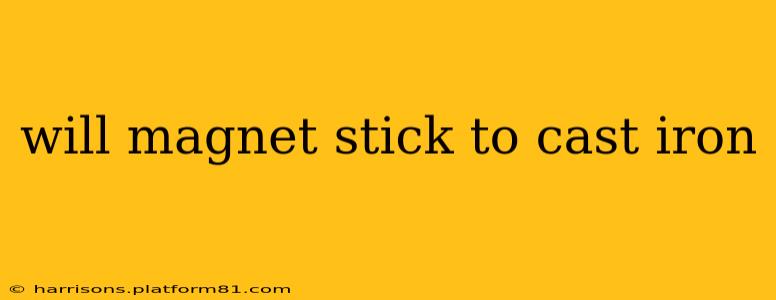Cast iron's magnetic properties are a common point of curiosity, especially for those working with metal or curious about magnetism. The short answer is: yes, most cast iron will stick to a magnet, but there are nuances to understand. This guide will explore why this is the case, delve into the exceptions, and answer some frequently asked questions.
Why Does a Magnet Stick to Cast Iron?
Cast iron is an alloy primarily composed of iron, carbon, and silicon. The high iron content is the key factor. Iron is a ferromagnetic material, meaning it can be strongly magnetized and will readily attract magnets. The presence of carbon and silicon affects the overall properties of the cast iron, including its strength and machinability, but generally doesn't significantly impair its magnetic susceptibility. Therefore, a magnet will generally adhere quite strongly to cast iron.
What Types of Cast Iron Are Magnetic?
The vast majority of cast iron types exhibit magnetic properties. This includes:
- Gray Cast Iron: The most common type, characterized by its graphite flakes.
- White Cast Iron: Contains less graphite and exhibits higher hardness.
- Ductile Iron (Nodular Iron): Possesses improved strength and ductility compared to gray iron.
These variations in cast iron composition may slightly alter the strength of magnetic attraction, but they generally remain magnetic.
What About Non-Magnetic Cast Iron? Are There Exceptions?
While rare, there are some very specific exceptions where cast iron might not strongly attract a magnet:
- Extremely High Carbon Content: An exceptionally high carbon content can interfere with the magnetic properties of the iron. However, this is uncommon in most commercially available cast iron.
- Alloying Elements: The addition of certain alloying elements in specific compositions might significantly reduce the magnetic response. This is again, a specialized case and not typical in everyday cast iron.
- Austenitic Cast Iron: This type of cast iron, which has a very specific chemical composition and processing method, is less magnetic than the other types. It’s used in situations where non-magnetic properties are desired.
How Strong Is the Magnetic Attraction to Cast Iron?
The strength of the magnetic attraction depends on several factors:
- Strength of the Magnet: A stronger magnet will naturally exhibit a stronger pull.
- Size and Shape of the Cast Iron: A larger piece of cast iron will generally have a stronger response.
- Type of Cast Iron: While most cast iron types are magnetic, slight variations in composition might impact the strength of attraction.
Generally, the attraction is sufficiently strong for everyday applications, such as using magnets to hold cast iron objects.
Does the Surface Finish of the Cast Iron Affect Magnetic Attraction?
A smooth, clean surface generally allows for better contact and thus stronger magnetic attraction. Rust, paint, or other coatings on the cast iron surface can reduce or prevent magnetic adhesion. Removing these surface imperfections will generally improve the magnetic interaction.
Can I Use a Magnet to Identify Cast Iron?
While magnetism is a good indicator, it's not a foolproof method for identifying cast iron. Other ferrous metals will also be magnetic. For definitive identification, you should rely on other testing methods as well.
What About Stainless Steel? Is it Magnetic?
This is a common point of confusion. While most stainless steels contain iron, some types (primarily austenitic grades) are non-magnetic due to their specific metallurgical composition. This is in contrast to most cast iron types.
In conclusion, while the vast majority of cast iron will readily stick to a magnet due to its high iron content, understanding the nuances of its composition and potential exceptions provides a more complete picture. Remember to always consider the strength of the magnet and the surface condition of the cast iron for optimal results.
